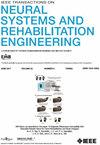新型运动-集成机器人步进装置的开发与验证
IF 4.8
2区 医学
Q2 ENGINEERING, BIOMEDICAL
IEEE Transactions on Neural Systems and Rehabilitation Engineering
Pub Date : 2025-04-22
DOI:10.1109/TNSRE.2025.3563191
引用次数: 0
摘要
对于能坐但不能站立或行走的患者,坐式康复在早期康复中是必不可少的。基于机器人的下肢康复为康复提供了精确的、特定任务的训练,但它在坐式锻炼中的应用仍然有限,在早期康复中造成了很大的差距。本研究提出了一种新型的运动-集成机器人步进器,用于坐式双侧和多关节下肢康复。20名健康的参与者进行了8种模式的坐式踏步练习:被动(G0)、三级辅助(G1-G3)、主动(G4)和三级抵抗(G5-G7)。结果显示踏步者的倾斜角度与踝关节、膝关节和髋关节之间有很强的相关性。该设备在所有模式下为这些关节保持一致的ROM,确保可靠的关节接合,无论阻力或辅助水平。重量漂移从被动(G0)逐渐增加到高阻力(G7),随着辅助减少和阻力增加,观察到更高的漂移。在辅助模式下,低辅助(G3)时体重漂移显著增加47.16% (p <0.0167)。在电阻模式下,在中等电阻(G6)和高电阻(G7)下,体重漂移显著增加了86.08%和129.7% (p <0.0167)。肌肉激活从被动(G0)到高阻力(G7)逐渐显著增加,随着辅助水平的降低和阻力水平的增加,观察到更大的激活(p <0.0083)。这些发现表明,机器人步进器可以作为进行性脑卒中康复的多功能工具,有效适应不同的康复需求,从早期支持到肌肉强化。本文章由计算机程序翻译,如有差异,请以英文原文为准。
Development and Validation of the Novel Exergame-Integrated Robotic Stepper Device for Seated Lower Limb Rehabilitation
Seated rehabilitation is essential in early-stage recovery for patients who can sit but cannot stand or walk. Robotic-based lower limb rehabilitation provides precise, task-specific training for recovery, but its application in seated exercises remains limited, creating a significant gap in early-stage rehabilitation. This study presents a novel exergame-integrated robotic stepper for seated bilateral and multi-joint lower limb rehabilitation. Twenty healthy participants performed seated stepping exercises across eight modes: passive (G0), three-level assistive(G1-G3), active (G4), and three-level resistive (G5-G7). Results demonstrated a strong correlation between the stepper’s tilt angle and the ankle, knee, and hip joints. The device maintained consistent ROM for these joints across all modes, ensuring reliable joint engagement regardless of resistance or assistance levels. Weight shift increased progressively from passive (G0) to high resistance (G7), with higher shifts observed as assistance decreased and resistance increased. In assistive modes, a significant increase of 47.16% in weight shift was observed at low assistance (G3) (p <0.0167). In resistive modes, weight shift increased significantly by 86.08% in medium resistance (G6) and by 129.7% at high resistance (G7) (p <0.0167). Muscle activation significantly increased progressively from passive (G0) to high resistance (G7), with greater activations observed as assistance levels decreased and resistance levels increased (p <0.0083). These findings indicate that robotic stepper can be a versatile tool in progressive stroke rehabilitation, effectively adapting to different rehabilitation needs, from early-stage support to muscle strengthening.
求助全文
通过发布文献求助,成功后即可免费获取论文全文。
去求助
来源期刊
CiteScore
8.60
自引率
8.20%
发文量
479
审稿时长
6-12 weeks
期刊介绍:
Rehabilitative and neural aspects of biomedical engineering, including functional electrical stimulation, acoustic dynamics, human performance measurement and analysis, nerve stimulation, electromyography, motor control and stimulation; and hardware and software applications for rehabilitation engineering and assistive devices.

 求助内容:
求助内容: 应助结果提醒方式:
应助结果提醒方式:


